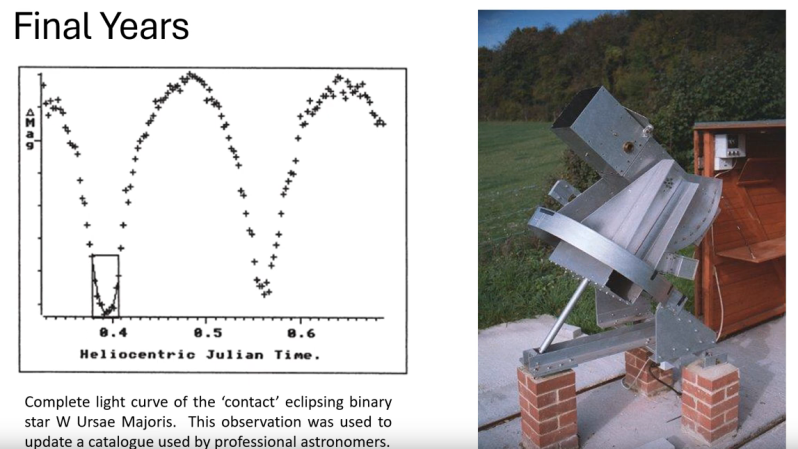Here at Hackaday, we take pride in presenting the freshest hacks and the best of what’s going on today in the world of hardware hacking. But sometimes, we stumble upon a hack from the past so compelling that we’ve got to bring it to you, so we can all marvel at what was possible in the Before Times.
This one, a completely homebrewed automatic photometric telescope, was designed and built by the father-son team of [Jack Ells] and [Peter Ells]. From the elder [Ells]’ field notes, the telescope saw its first light in 1988, giving us some idea of the scale of problems that had to be overcome to get this wonderful machine working. The optics are straightforward, as least as telescopes go — it’s an f-4.0 Newtonian reflector with an 8.5″ (221 mm) primary mirror on an equatorial mount. The telescope is very rugged-looking indeed, and even stands on brick piers for stability. The telescope’s mount is controlled by a BBC Micro running custom BASIC software.
For the photometric parts, the [Ells] boys installed a photo-multiplier tube at the focus of the telescope. More precisely, they used a liquid light guide to connect the eyepiece to a rack full of equipment, which included the PM tube, its high-voltage power supply, and a series of signal conditioners and counter circuits. The idea was to view a single star through a pinhole mask over the objective of the telescope and count the rate of photons received over time. Doing so would reveal periodic changes in the star’s brightness. Today we’d use similar data to search for exoplanet transits; while we don’t think that was a thing back in 1988, it looks like this telescope could easily have handled the job.
Sadly, [Jack Ells] died only two years after finishing the telescope. But he left it with his son, who eventually moved it to a location with better seeing conditions, where it gathered data for another eight years. The quality of the work is amazing, and as father-son projects go, this one is tough to beat.
















I would like to know where to get all available original, and first-source information on this effort.
Everything–from the (obviously) hand-ground optics; to the very robust equatorial mount; to the liquid light-pipe…) about this project screams “dedicated, extremely-hard-work science and engineering and sweat”, and not merely and simply (with all due respect to this venue), “…a pretty good hack…”.
The entire effort put into this project is so good, so well-thought-out, and so highly professional that it absolutely must have been reported in much more detail elsewhere.
Please give us those details.
Have you checked the video description on youtube? There are some pdf references, and the video is by one of men who built it.
Yes, of course I have.
Those are not the quality of the provenance I am seeking, or that we all should have access to.
I would like Hackaday to provide its original sources.
Hackaday’s original source is the youtube video and the pdfs and resources therein. What sort of provenance are you seeking if not the paper written about the system by the guys who designed, built, tested, and operated the system?
I think it is amazing that in the 1980’s, the telescope drive system, photometry system, and computer were combined to complete an automatic observation system for variable stars, and that he was able to evaluate the observation results.
I also wanted to try photometry of celestial objects at that time, but I could not prepare a PMT and a high-voltage power supply, so I experimented with photodiodes and operational amplifiers. The result was limited to stars as bright as Jupiter. I am deeply moved by this introductory video because I recently built a telescope drive system with my own computer using the same 6502 CPU as the BBC Micro.